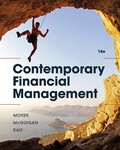
EBK CONTEMPORARY FINANCIAL MANAGEMENT
14th Edition
ISBN: 9781337514835
Author: MOYER
Publisher: CENGAGE LEARNING - CONSIGNMENT
expand_more
expand_more
format_list_bulleted
Question
Chapter 14, Problem 18P
a.
Summary Introduction
To compute: Degree of operating leverage.
b.
Summary Introduction
To determine: Graphically indifference points representation of EBIT-EPS.
c.
Summary Introduction
To determine: Impact on indifference point.
d.
Summary Introduction
To determine: Impact on indifference point.
Expert Solution & Answer
Want to see the full answer?
Check out a sample textbook solution
Students have asked these similar questions
What are the tax advantages of investing through a Roth IRA in finance?
need help
What are the tax advantages of investing through a Roth IRA in finance ?
no ai
What are the tax advantages of investing through a Roth IRA in finance?
Chapter 14 Solutions
EBK CONTEMPORARY FINANCIAL MANAGEMENT
Ch. 14.A - Prob. 1QTDCh. 14.A - Prob. 2QTDCh. 14.A - Prob. 3QTDCh. 14.A - Prob. 2PCh. 14.A - Prob. 3PCh. 14.A - Prob. 4PCh. 14.A - Prob. 5PCh. 14.A - Prob. 6PCh. 14.A - Prob. 7PCh. 14.A - Prob. 8P
Ch. 14 - Prob. 1QTDCh. 14 - Prob. 2QTDCh. 14 - Prob. 3QTDCh. 14 - Prob. 4QTDCh. 14 - Prob. 5QTDCh. 14 - Prob. 6QTDCh. 14 - Prob. 7QTDCh. 14 - Prob. 8QTDCh. 14 - Prob. 9QTDCh. 14 - Prob. 10QTDCh. 14 - Prob. 11QTDCh. 14 - Prob. 1PCh. 14 - Prob. 2PCh. 14 - Prob. 3PCh. 14 - Prob. 4PCh. 14 - Prob. 5PCh. 14 - Prob. 6PCh. 14 - Prob. 7PCh. 14 - Prob. 8PCh. 14 - Prob. 9PCh. 14 - Prob. 10PCh. 14 - Prob. 11PCh. 14 - Prob. 12PCh. 14 - Prob. 13PCh. 14 - Prob. 14PCh. 14 - Prob. 15PCh. 14 - Prob. 16PCh. 14 - Prob. 17PCh. 14 - Prob. 18PCh. 14 - Prob. 19PCh. 14 - Prob. 20PCh. 14 - Prob. 21PCh. 14 - Prob. 22PCh. 14 - Prob. 23PCh. 14 - Prob. 24PCh. 14 - Prob. 25PCh. 14 - Prob. 26PCh. 14 - Prob. 27PCh. 14 - Prob. 28PCh. 14 - Prob. 29PCh. 14 - Prob. 30PCh. 14 - Prob. 31PCh. 14 - Prob. 32PCh. 14 - Prob. 33PCh. 14 - Prob. 34P
Knowledge Booster
Learn more about
Need a deep-dive on the concept behind this application? Look no further. Learn more about this topic, finance and related others by exploring similar questions and additional content below.Similar questions
- What is the 4% rule in retirement planning in finance?arrow_forward(Calculating NPV) Carson Trucking is considering whether to expand its regional service center in Moab, Utah. The expansion will require the expenditure of $10,000,000 on new service equipment and will generate annual net cash inflows from reduced costs of operations equal to $2,500,000 per year for each of the next 8 years. In year 8, the firm will also get back a cash flow equal to the salvage value of the equipment, which is valued at $1 million. Thus, in year 8, the investment cash inflow will total $3,500,000. Calculate the project's NPV using a discount rate of 9 percent. If the discount rate is 9 percent, then the project's NPV is (round your answer to the nearest dollar) Sarrow_forward(Calculating annuity payments) The Aggarwal Corporation needs to save $7 million to retire a(n) $7 million mortgage that matures in 17 years. To retire this mortgage, the company plans to put a fixed amount into an account at the end of each year for 17 years. The Aggarwal Corporation expects to earn 13 percent annually on the money in this account. What equal annual contribution must the firm make to this account to accumulate the $7 million by the end of 17 years? The equal annual contribution Aggarwal must make to this account is (round your answer to the nearest cent) $.arrow_forward
- (Calculating NPV) Big Steve's Swizzle Sticks is considering the purchase of a new plastic stamping machine. This investment will require an initial outlay of $95,000 and will generate net cash inflows of $17,000 per year for 11 years. a. What is the project's NPV using a discount rate of 13 percent? Should the project be accepted? Why or why not? b. What is the project's NPV using a discount rate of 14 percent? Should the project be accepted? Why or why not? c. What is this project's IRR? Should the project be accepted? Why or why not?arrow_forwardThe number of years it will take for $490 to grow to $1,057.86 at 7 percent compounded annually is (type your answer in years, round to one decimal place) years.arrow_forwardThe number of years it will take for $500 to grow to $1,039.50 at 5 percent compounded annually is (type your answer in years, round to one decimal place) years.arrow_forward
- (Round your answer to the nearest cent.) $5,000 invested for 10 years at 10 percent compounded annually will accumulate to $arrow_forwardWhat is the difference between operating leverage and financial leverage in finance? i need coarrow_forwardWhat is the Sharpe ratio and how is it used to evaluate investments? need helparrow_forward
arrow_back_ios
SEE MORE QUESTIONS
arrow_forward_ios
Recommended textbooks for you
 EBK CONTEMPORARY FINANCIAL MANAGEMENTFinanceISBN:9781337514835Author:MOYERPublisher:CENGAGE LEARNING - CONSIGNMENT
EBK CONTEMPORARY FINANCIAL MANAGEMENTFinanceISBN:9781337514835Author:MOYERPublisher:CENGAGE LEARNING - CONSIGNMENT

EBK CONTEMPORARY FINANCIAL MANAGEMENT
Finance
ISBN:9781337514835
Author:MOYER
Publisher:CENGAGE LEARNING - CONSIGNMENT
Discounted cash flow model; Author: Edspira;https://www.youtube.com/watch?v=7PpWneOBJls;License: Standard YouTube License, CC-BY